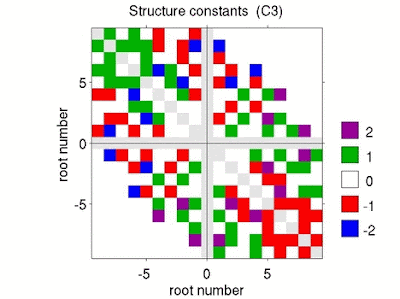When looking at the three \(\mathfrak{su}(2)\) generator matrices
\[
\begin{equation}
t_x = \frac{i}{2}\,\begin{pmatrix}
0 & -1 \\
-1 & 0 \end{pmatrix}\\
t_y = \frac{i}{2}\,\begin{pmatrix}
0 & i \\
-i & 0 \end{pmatrix}\\
t_z = \frac{i}{2}\,\begin{pmatrix}
-1 & 0 \\0 & 1
\end{pmatrix}
\label{lasu3:eq:repre1}
\end{equation}
\] (see this
post) one could be tempted to assume that the nine matrices
\[
\begin{equation}
t_x = \frac{i}{2}\,\begin{pmatrix}
0 & -1 & 0\\
-1 & 0 & 0\\
0 & 0 & 0 \end{pmatrix}\qquad
t_y = \frac{i}{2}\,\begin{pmatrix}
0 & i & 0 \\
-i & 0 & 0 \\
0 & 0 & 0 \end{pmatrix}\\
t_z = \frac{i}{2}\,\begin{pmatrix}
-1 & 0 & 0 \\
0 & 1 & 0 \\
0 & 0 & 0 \end{pmatrix}\qquad
u_x = \frac{i}{2}\,\begin{pmatrix}
0 & 0 & 0\\
0 & 0 & -1\\
0 & -1 & 0 \end{pmatrix}\\
u_y = \frac{i}{2}\,\begin{pmatrix}
0 & 0 & 0 \\
0 & 0 & i \\
0 & -i & 0 \end{pmatrix}\qquad
u_z = \frac{i}{2}\,\begin{pmatrix}
0 & 0 & 0 \\
0 & -1 & 0 \\
0 & 0 & 1 \end{pmatrix}\\
v_x = \frac{i}{2}\,\begin{pmatrix}
0 & 0 & -1\\
0 & 0 & 0\\
-1 & 0 & 0 \end{pmatrix}\qquad
v_y = \frac{i}{2}\,\begin{pmatrix}
0 & 0 & i \\
0 & 0 & 0 \\
-i & 0 & 0 \end{pmatrix}\\
v_z = \frac{i}{2}\,\begin{pmatrix}
-1 & 0 & 0 \\
0 & 0 & 0 \\
0 & 0 & 1 \end{pmatrix}
\label{lasu3:eq:repre2}
\end{equation}
\] form a Lie algebra as well. Calculation of all 81 commutators (Lie products) yields :
|
\(t_x\) |
\(t_y\) |
\(t_z\) |
\(u_x\) |
\(u_y\) |
\(u_z\) |
\(v_x\) |
\(v_y\) |
\(v_z\) |
| \(t_x\) |
\(0\) |
\(t_z\) |
\(-t_y\) |
\({v_y\over 2}\) |
\(-{v_x\over 2}\) |
\({t_y\over 2}\) |
\({u_y\over 2}\) |
\(-{u_x\over 2}\) |
\(-{t_y\over 2}\) |
| \(t_y\) |
\(-t_z\) |
\(0\) |
\(t_x\) |
\(-{v_x\over 2}\) |
\({v_y\over 2}\) |
\(-{t_x\over 2}\) |
\(-{u_x\over 2}\) |
\({u_y\over 2}\) |
\({t_x\over 2}\) |
| \(t_z\) |
\(t_y\) |
\(-t_x\) |
\(0\) |
\(-{u_y\over 2}\) |
\({u_x\over 2}\) |
\(0\) |
\({v_y\over 2}\) |
\(-{v_x\over 2}\) |
\(0\) |
| \(u_x\) |
\(-{v_y\over 2}\) |
\({v_x\over 2}\) |
\({u_y\over 2}\) |
\(0\) |
\(u_z\) |
\(-u_y\) |
\(-{t_y\over 2}\) |
\({t_x\over 2}\) |
\(-{u_y\over 2}\) |
| \(u_y\) |
\({v_x\over 2}\) |
\(-{v_y\over 2}\) |
\(-{u_x\over 2}\) |
\(-u_z\) |
\(0\) |
\(u_x\) |
\(-{t_x\over 2}\) |
\({t_y\over 2}\) |
\({u_x\over 2}\) |
| \(u_z\) |
\(-{t_y\over 2}\) |
\({t_x\over 2}\) |
\(0\) |
\(u_y\) |
\(-u_x\) |
\(0\) |
\({v_y\over 2}\) |
\(-{v_x\over 2}\) |
\(0\) |
| \(v_x\) |
\(-{u_y\over 2}\) |
\({u_x\over 2}\) |
\(-{v_y\over 2}\) |
\({t_y\over 2}\) |
\({t_x\over 2}\) |
\(-{v_y\over 2}\) |
\(0\) |
\(v_z\) |
\(-v_y\) |
| \(v_y\) |
\({u_x\over 2}\) |
\(-{u_y\over 2}\) |
\({v_x\over 2}\) |
\(-{t_x\over 2}\) |
\(-{t_y\over 2}\) |
\({v_x\over 2}\) |
\(-v_z\) |
\(0\) |
\(v_x\) |
| \(v_z\) |
\({t_y\over 2}\) |
\(-{t_x\over 2}\) |
\(0\) |
\({u_y\over 2}\) |
\(-{u_x\over 2}\) |
\(0\) |
\(v_y\) |
\(-v_x\) |
\(0\) |
(The row value is the first entry, the column value the seconds entry in the commutator \([\cdot, \cdot]\).) The yellow-colored values mark the Lie product of \(t_x\), \(t_y\), \(t_z\) with themselves (green for \(u_x\), \(u_y\), \(u_z\), blue for \(v_x\), \(v_y\), \(v_z\)) and suggest that this algebra includes three copies of \(su(2)\).
Alas, the set \(t_x\), \(t_y\), \(t_z\), \(u_x\), \(u_y\), \(u_z\), \(v_x\), \(v_y\) and \(v_z\) doesn't form a basis since only eight of the nine vectors are linear independent. E.g., we find \(v_z = t_z + u_z\) and we could choose the eight elements \(t_x\), \(t_y\), \(t_z\), \(u_x\), \(u_y\), \(u_z\), \(v_x\), \(v_y\). Of course, instead of \(v_z\) we could just as well disregard \(t_z\) or \(u_z\). Either way, the multiplication table loses its nice symmetry and, for the set \(t_x\), \(t_y\), \(t_z\), \(u_x\), \(u_y\), \(u_z\), \(v_x\), \(v_y\), looks like this
|
\(t_x\) |
\(t_y\) |
\(t_z\) |
\(u_x\) |
\(u_y\) |
\(u_z\) |
\(v_x\) |
\(v_y\) |
| \(t_x\) |
\(0\) |
\(t_z\) |
\(-t_y\) |
\({v_y\over 2}\) |
\(-{v_x\over 2}\) |
\({t_y\over 2}\) |
\({u_y\over 2}\) |
\(-{u_x\over 2}\) |
| \(t_y\) |
\(-t_z\) |
\(0\) |
\(t_x\) |
\(-{v_x\over 2}\) |
\({v_y\over 2}\) |
\(-{t_x\over 2}\) |
\(-{u_x\over 2}\) |
\({u_y\over 2}\) |
| \(t_z\) |
\(t_y\) |
\(-t_x\) |
\(0\) |
\(-{u_y\over 2}\) |
\({u_x\over 2}\) |
\(0\) |
\({v_y\over 2}\) |
\(-{v_x\over 2}\) |
| \(u_x\) |
\(-{v_y\over 2}\) |
\({v_x\over 2}\) |
\({u_y\over 2}\) |
\(0\) |
\(u_z\) |
\(-u_y\) |
\(-{t_y\over 2}\) |
\({t_x\over 2}\) |
| \(u_y\) |
\({v_x\over 2}\) |
\(-{v_y\over 2}\) |
\(-{u_x\over 2}\) |
\(-u_z\) |
\(0\) |
\(u_x\) |
\(-{t_x\over 2}\) |
\({t_y\over 2}\) |
| \(u_z\) |
\(-{t_y\over 2}\) |
\({t_x\over 2}\) |
\(0\) |
\(u_y\) |
\(-u_x\) |
\(0\) |
\({v_y\over 2}\) |
\(-{v_x\over 2}\) |
| \(v_x\) |
\(-{u_y\over 2}\) |
\({u_x\over 2}\) |
\(-{v_y\over 2}\) |
\({t_y\over 2}\) |
\({t_x\over 2}\) |
\(-{v_y\over 2}\) |
\(0\) |
\(t_z+u_z\) |
| \(v_y\) |
\({u_x\over 2}\) |
\(-{u_y\over 2}\) |
\({v_x\over 2}\) |
\(-{t_x\over 2}\) |
\(-{t_y\over 2}\) |
\({v_x\over 2}\) |
\(-(t_z+u_z)\) |
\(0\) |
In order to show that \(t_x\), \(t_y\), \(t_z\), \(u_x\), \(u_y\), \(u_z\), \(v_x\), \(v_y\) with the Lie multiplication table shown above is indeed a Lie algebra, it needs to be checked that
\[
\begin{equation*}
[a, b] = -[b, a] \\
[a, [b, c]] + [b, [c, a]] + [c, [a, b]] = 0
\end{equation*}
\]
The first equation (anti-symmetry) is valid since the entries in the table form an anti-symmetric matrix. The second (Jacobi identity) needs to be checked for all \(8\cdot 8\cdot 8 = 512\) possibilities, which did my computer for me. The Lie algebra of the eight vectors \(t_x\), \(t_y\), \(t_z\), \(u_x\), \(u_y\), \(u_z\), \(v_x\), \(v_y\) with the multiplication table above form the Lie algebra
\(\mathfrak{su}(3) \).














